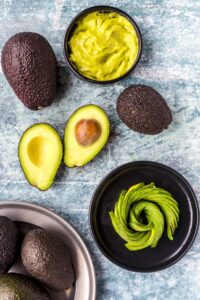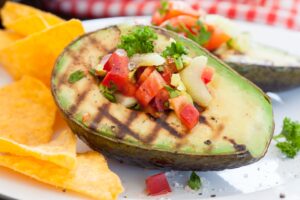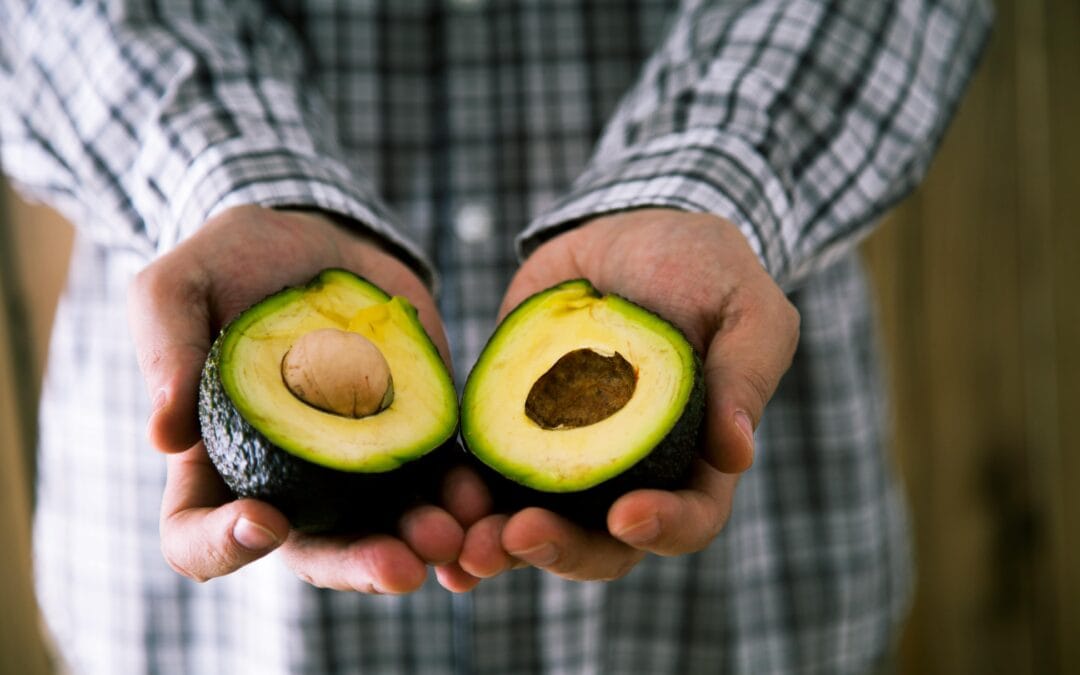Avocados have become extremely popular in the last few years, so popular that they’ve been blamed as the reason that Millennials can’t afford houses.
However, many nutritionists have already begun calling the avocado a “superfood,” even with how high it’s fat content and calories per serving can be. What kind of nutrition can avocados offer us? And can we leverage this new food to fill blind spots in our daily nutrition?
We’ll look into what an avocado is, where they come from, and then get into their nutrition, along with great ways to incorporate them into your daily diet!
What Is An Avocado?

An avocado is a palm-sized green fruit with a large pit and rough, leathery skin. They’re also known as alligator pears or butter fruit, due to the way their flesh is spreadable. They’re originally from Mexico and are grown in warmer climates. Avocados are typically found in the produce section, and they’re a whole lot easier to find in recent years as their popularity has skyrocketed. This pear-shaped berry (yes, that’s right!) is actually classified as a superfood!
An avocado is made up of three parts: skin, flesh, and a seed. The skin is dark green and rough. There’s very little in the way of edible nutrition. When cut open, the avocado has a large, circular, brown seed. The seed is also not edible, but many people have been growing avocado trees from the seeds. The bright green flesh surrounding the seed is what you’re looking for.
The flesh is creamy smooth, which makes it easy to handle. However, it doesn’t have the greatest flavor by itself. It often is added to other recipes as a texture enhancer, as well as being nutritionally dense. Let’s look at what makes it so rich in helpful nutrients.
Avocado Nutrition
One-half of an avocado, which is about 100g, contains 160 calories, 2g of protein, 8.5g of carbohydrates, and 14.7g of fat. While that fat number looks scary, it’s much better when we look at what kind of fat it is. Two thirds of the fat, in this case, 9.3g, is monounsaturated fat, which is actually not bad for you. These healthy fats help lower other unhealthy fat levels which have been found in some cases to decrease your risk of stroke or a heart attack. They also have a low glycemic index rating of almost zero, which means that they have little effect on blood sugar. This is great for people looking to better manage diabetes: you can gain a lot of nutrition from a source with almost no sugar.
In terms of nutrients, it’s full of them. Each half of an avocado contains the following daily percentages:
- Vitamin B-5: 28%
- Copper: 21%
- Folate: 20%
- Vitamin K: 18%
- Vitamin B-6: 15%
- Vitamin E: 14%
- Vitamin C: 11%
- Vitamin B-3: 11%
- Potassium: 10%
- Magnesium: 7%
- Manganese: 6%
- Vitamin B-1: 6%
- Zinc: 6%
It certainly lives up to its name! Even though one serving is somewhat calorie heavy, it contains almost every nutrient you could ever need. It’s even got more potassium per serving than a banana. Avocados are definitely not empty calories; you’re gaining a lot from just one, green berry!
In every 100 g of avocado there’s also 76mg of a natural plant sterol called beta sitosterol. Researchers have found that regularly consuming beta sitosterol and other plant sterols may assist in maintaining healthy cholesterol levels, which are important for heart health.
Ways To Eat It
An avocado’s flesh is the most common part of the avocado that’s eaten. The skin tends to be rough and tough to eat, and while some varieties of avocados have lighter, less tough skin that is sometimes incorporated with the avocado flesh, most people just chuck it or put it in a compost pile. As well, the avocado seed is really only edible once its dried out, but in the drying out process, it loses a lot of its nutrients.
The flesh, though, can be used in a lot of different ways. Many times it’s added to toast with some salt and pepper as a simple breakfast item. However, compared to just having a piece of toast, avocado toast is significantly better for you, no matter what investors tell you. Just make sure that the flesh is fresh: avocado that’s gone bad typically goes from light green to brown, as well as becoming a bit more mushy than usual.
 Another popular way to eat avocado is with guacamole. In a medium bowl, mash together a few avocados, lime juice, and salt. Mix in chopped onion, cilantro, tomatoes, and garlic. For an extra kick, stir in some cayenne pepper. You can refrigerate 1 hour for best flavor or serve immediately. People often each guacamole with chips, so finding a healthier chip might help boost the few areas avocados don’t hold nutrients and turn this yummy treat into a super snack!
Another popular way to eat avocado is with guacamole. In a medium bowl, mash together a few avocados, lime juice, and salt. Mix in chopped onion, cilantro, tomatoes, and garlic. For an extra kick, stir in some cayenne pepper. You can refrigerate 1 hour for best flavor or serve immediately. People often each guacamole with chips, so finding a healthier chip might help boost the few areas avocados don’t hold nutrients and turn this yummy treat into a super snack!
Avocado is frequently substituted in recipes using mayonnaise as a binder ingredient. Mayonnaise isn’t very nutritionally interesting, so replacing mayo with avocado can be a small way to create big changes in certain recipes. It’s also a great addition to salads, either diced or sliced, without much hassle.
Avocados can even be used as a side dish for full meals. You can cut them in half, pop out the seed, and grill the halves with some oil, salt, pepper, and lemon juice, or you can cut the flesh into fries that you can either deep fry, bake, or air fry. Air frying and baking are obviously much healthier than deep frying, though, so watch how you cook them.
Super Food? Super Yes!
While it’s a bit calorie heavy, there’s no denying the true diversity of nutrition that a serving of avocado can give you. Vitamins, minerals, healthy forms of fat, all within one food that can be anything from a dip, an ingredient substitution, a side dish, or even a whole meal. It’s no wonder why avocados are called super foods: they’re super for your nutrition and your health! Try adding it into your daily diet and improving your healthy habits, one food at a time.

